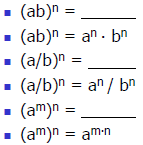Exponents
 Section P.2
Section P.2
Exponential Notation
for Positive Integers
 Let b be a real number or a variable
Let b be a real number or a variable
representing a real number. Let n be a
positive integer.

 where there are n b’s
where there are n b’s
 Example:
Example: 
 Example:
Example:

Product Rule for Exponents
 What happens to the exponents when
What happens to the exponents when
we multiply 
 Solution :
Solution :

Exponential Rules
 We want the Product Rule for
We want the Product Rule for
Exponents to hold for
powers that are
not positive integers as well. Determine
the definition of each
of the following
exponential rules by ensuring that the
Product Rule for
Exponents holds.
 For any real number a ,
what does
For any real number a ,
what does 
 Solution
Solution
 We want to define a zero power so that
We want to define a zero power so that

 What must a0equal for this to happen?
What must a0equal for this to happen?


 For any real number a,
what does
For any real number a,
what does 
 Solution
Solution
 We want to define a negative power so that
We want to define a negative power so that

 What must
What must  equal for this to happen?
equal for this to happen?

 so a negative power means
so a negative power means
reciprocal
Division Rule for Exponents
 For any non-zero real number a, what
For any non-zero real number a, what
does 
 Solution
Solution
 Using the rule for negative exponents
Using the rule for negative exponents

 So when we divide expressions with the
So when we divide expressions with the
same base, we subtract powers.
Other Exponential Rules
 Determine the rules for the following by
Determine the rules for the following by
expanding the
expression .

Skills
 Use the Exponential Rules to simplify
Use the Exponential Rules to simplify
the following
expressions to a common
form having
![]() Only positive exponents
Only positive exponents
![]() All like terms combined
All like terms combined
![]() Constant portion reduced to lowest terms
Constant portion reduced to lowest terms
Skills Practice

 How do we extend the notion of exponents to
How do we extend the notion of exponents to
the rational numbers? What is 
 Solution:
Solution:
 Using the Power to a power rule, examine
Using the Power to a power rule, examine
 So the power 1/n undoes
So the power 1/n undoes
the power n. What operation undoes
taking
an nth power?
 Example: a2 can be undone by taking
Example: a2 can be undone by taking
 that
that
is . ,So we define
,So we define

Radical Rules
 Simplifying expressions that have
Simplifying expressions that have
radicals can be done
by converting the
radical to a rational power and then
applying the exponential
rules. Try one
of these three examples.

 Common simplified form for radical
Common simplified form for radical
expressions is
 All factors removed from radical
All factors removed from radical
 Index of radical reduced to lowest terms
Index of radical reduced to lowest terms
 Rationalize the denominator (no radical left
Rationalize the denominator (no radical left
in the denominator)
Skills Practice
 Simplify the following radical expression
Simplify the following radical expression

| Prev | Next |